Narendra Ahuja
RGB-Only Supervised Camera Parameter Optimization in Dynamic Scenes
Sep 18, 2025

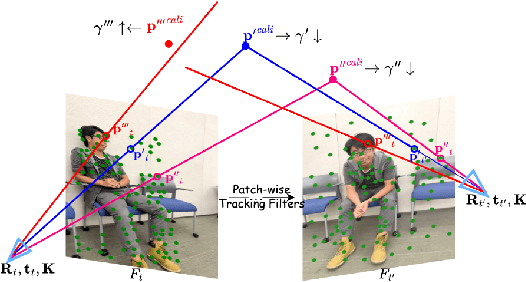
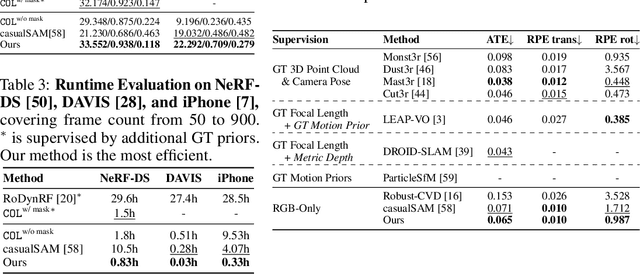
Abstract:Although COLMAP has long remained the predominant method for camera parameter optimization in static scenes, it is constrained by its lengthy runtime and reliance on ground truth (GT) motion masks for application to dynamic scenes. Many efforts attempted to improve it by incorporating more priors as supervision such as GT focal length, motion masks, 3D point clouds, camera poses, and metric depth, which, however, are typically unavailable in casually captured RGB videos. In this paper, we propose a novel method for more accurate and efficient camera parameter optimization in dynamic scenes solely supervised by a single RGB video. Our method consists of three key components: (1) Patch-wise Tracking Filters, to establish robust and maximally sparse hinge-like relations across the RGB video. (2) Outlier-aware Joint Optimization, for efficient camera parameter optimization by adaptive down-weighting of moving outliers, without reliance on motion priors. (3) A Two-stage Optimization Strategy, to enhance stability and optimization speed by a trade-off between the Softplus limits and convex minima in losses. We visually and numerically evaluate our camera estimates. To further validate accuracy, we feed the camera estimates into a 4D reconstruction method and assess the resulting 3D scenes, and rendered 2D RGB and depth maps. We perform experiments on 4 real-world datasets (NeRF-DS, DAVIS, iPhone, and TUM-dynamics) and 1 synthetic dataset (MPI-Sintel), demonstrating that our method estimates camera parameters more efficiently and accurately with a single RGB video as the only supervision.
PhysRig: Differentiable Physics-Based Skinning and Rigging Framework for Realistic Articulated Object Modeling
Jun 26, 2025Abstract:Skinning and rigging are fundamental components in animation, articulated object reconstruction, motion transfer, and 4D generation. Existing approaches predominantly rely on Linear Blend Skinning (LBS), due to its simplicity and differentiability. However, LBS introduces artifacts such as volume loss and unnatural deformations, and it fails to model elastic materials like soft tissues, fur, and flexible appendages (e.g., elephant trunks, ears, and fatty tissues). In this work, we propose PhysRig: a differentiable physics-based skinning and rigging framework that overcomes these limitations by embedding the rigid skeleton into a volumetric representation (e.g., a tetrahedral mesh), which is simulated as a deformable soft-body structure driven by the animated skeleton. Our method leverages continuum mechanics and discretizes the object as particles embedded in an Eulerian background grid to ensure differentiability with respect to both material properties and skeletal motion. Additionally, we introduce material prototypes, significantly reducing the learning space while maintaining high expressiveness. To evaluate our framework, we construct a comprehensive synthetic dataset using meshes from Objaverse, The Amazing Animals Zoo, and MixaMo, covering diverse object categories and motion patterns. Our method consistently outperforms traditional LBS-based approaches, generating more realistic and physically plausible results. Furthermore, we demonstrate the applicability of our framework in the pose transfer task highlighting its versatility for articulated object modeling.
Towards Spatially-Aware and Optimally Faithful Concept-Based Explanations
Apr 15, 2025Abstract:Post-hoc, unsupervised concept-based explanation methods (U-CBEMs) are a promising tool for generating semantic explanations of the decision-making processes in deep neural networks, having applications in both model improvement and understanding. It is vital that the explanation is accurate, or faithful, to the model, yet we identify several limitations of prior faithfulness metrics that inhibit an accurate evaluation; most notably, prior metrics involve only the set of concepts present, ignoring how they may be spatially distributed. We address these limitations with Surrogate Faithfulness (SF), an evaluation method that introduces a spatially-aware surrogate and two novel faithfulness metrics. Using SF, we produce Optimally Faithful (OF) explanations, where concepts are found that maximize faithfulness. Our experiments show that (1) adding spatial-awareness to prior U-CBEMs increases faithfulness in all cases; (2) OF produces significantly more faithful explanations than prior U-CBEMs (30% or higher improvement in error); (3) OF's learned concepts generalize well to out-of-domain data and are more robust to adversarial examples, where prior U-CBEMs struggle.
Disentangling CLIP Features for Enhanced Localized Understanding
Feb 05, 2025Abstract:Vision-language models (VLMs) demonstrate impressive capabilities in coarse-grained tasks like image classification and retrieval. However, they struggle with fine-grained tasks that require localized understanding. To investigate this weakness, we comprehensively analyze CLIP features and identify an important issue: semantic features are highly correlated. Specifically, the features of a class encode information about other classes, which we call mutual feature information (MFI). This mutual information becomes evident when we query a specific class and unrelated objects are activated along with the target class. To address this issue, we propose Unmix-CLIP, a novel framework designed to reduce MFI and improve feature disentanglement. We introduce MFI loss, which explicitly separates text features by projecting them into a space where inter-class similarity is minimized. To ensure a corresponding separation in image features, we use multi-label recognition (MLR) to align the image features with the separated text features. This ensures that both image and text features are disentangled and aligned across modalities, improving feature separation for downstream tasks. For the COCO- 14 dataset, Unmix-CLIP reduces feature similarity by 24.9%. We demonstrate its effectiveness through extensive evaluations of MLR and zeroshot semantic segmentation (ZS3). In MLR, our method performs competitively on the VOC2007 and surpasses SOTA approaches on the COCO-14 dataset, using fewer training parameters. Additionally, Unmix-CLIP consistently outperforms existing ZS3 methods on COCO and VOC
R2I-rPPG: A Robust Region of Interest Selection Method for Remote Photoplethysmography to Extract Heart Rate
Oct 21, 2024



Abstract:The COVID-19 pandemic has underscored the need for low-cost, scalable approaches to measuring contactless vital signs, either during initial triage at a healthcare facility or virtual telemedicine visits. Remote photoplethysmography (rPPG) can accurately estimate heart rate (HR) when applied to close-up videos of healthy volunteers in well-lit laboratory settings. However, results from such highly optimized laboratory studies may not be readily translated to healthcare settings. One significant barrier to the practical application of rPPG in health care is the accurate localization of the region of interest (ROI). Clinical or telemedicine visits may involve sub-optimal lighting, movement artifacts, variable camera angle, and subject distance. This paper presents an rPPG ROI selection method based on 3D facial landmarks and patient head yaw angle. We then demonstrate the robustness of this ROI selection method when coupled to the Plane-Orthogonal-to-Skin (POS) rPPG method when applied to videos of patients presenting to an Emergency Department for respiratory complaints. Our results demonstrate the effectiveness of our proposed approach in improving the accuracy and robustness of rPPG in a challenging clinical environment.
Rethinking Prompting Strategies for Multi-Label Recognition with Partial Annotations
Sep 12, 2024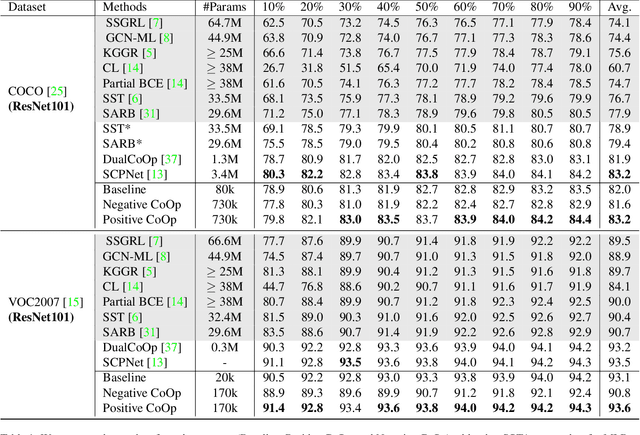
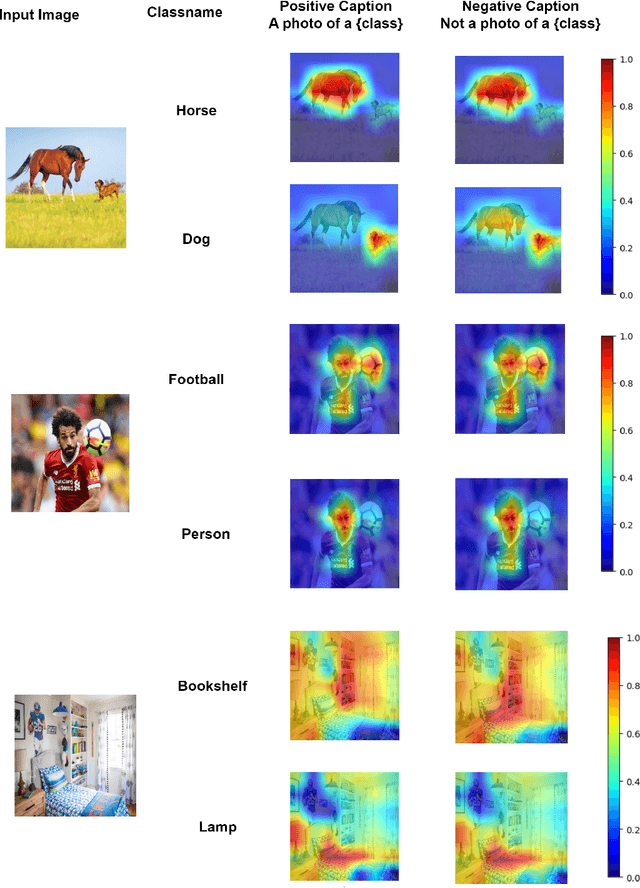
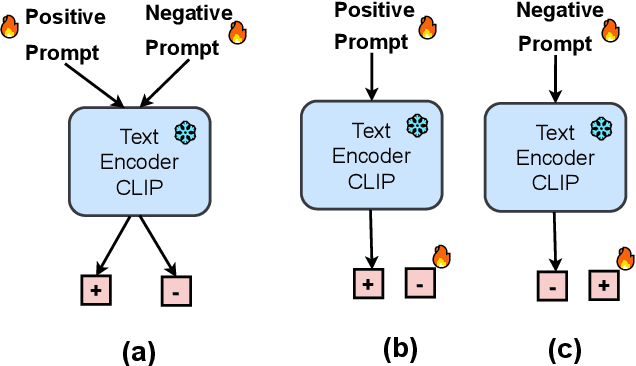
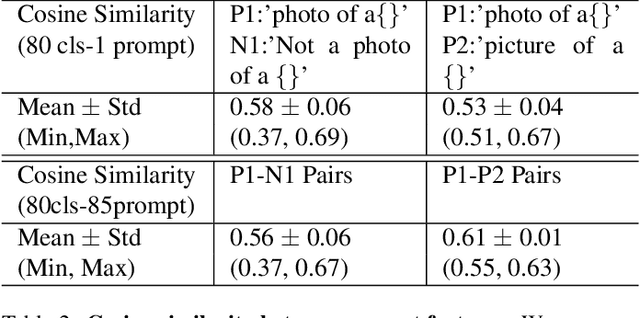
Abstract:Vision-language models (VLMs) like CLIP have been adapted for Multi-Label Recognition (MLR) with partial annotations by leveraging prompt-learning, where positive and negative prompts are learned for each class to associate their embeddings with class presence or absence in the shared vision-text feature space. While this approach improves MLR performance by relying on VLM priors, we hypothesize that learning negative prompts may be suboptimal, as the datasets used to train VLMs lack image-caption pairs explicitly focusing on class absence. To analyze the impact of positive and negative prompt learning on MLR, we introduce PositiveCoOp and NegativeCoOp, where only one prompt is learned with VLM guidance while the other is replaced by an embedding vector learned directly in the shared feature space without relying on the text encoder. Through empirical analysis, we observe that negative prompts degrade MLR performance, and learning only positive prompts, combined with learned negative embeddings (PositiveCoOp), outperforms dual prompt learning approaches. Moreover, we quantify the performance benefits that prompt-learning offers over a simple vision-features-only baseline, observing that the baseline displays strong performance comparable to dual prompt learning approach (DualCoOp), when the proportion of missing labels is low, while requiring half the training compute and 16 times fewer parameters
Self-Calibrating 4D Novel View Synthesis from Monocular Videos Using Gaussian Splatting
Jun 03, 2024Abstract:Gaussian Splatting (GS) has significantly elevated scene reconstruction efficiency and novel view synthesis (NVS) accuracy compared to Neural Radiance Fields (NeRF), particularly for dynamic scenes. However, current 4D NVS methods, whether based on GS or NeRF, primarily rely on camera parameters provided by COLMAP and even utilize sparse point clouds generated by COLMAP for initialization, which lack accuracy as well are time-consuming. This sometimes results in poor dynamic scene representation, especially in scenes with large object movements, or extreme camera conditions e.g. small translations combined with large rotations. Some studies simultaneously optimize the estimation of camera parameters and scenes, supervised by additional information like depth, optical flow, etc. obtained from off-the-shelf models. Using this unverified information as ground truth can reduce robustness and accuracy, which does frequently occur for long monocular videos (with e.g. > hundreds of frames). We propose a novel approach that learns a high-fidelity 4D GS scene representation with self-calibration of camera parameters. It includes the extraction of 2D point features that robustly represent 3D structure, and their use for subsequent joint optimization of camera parameters and 3D structure towards overall 4D scene optimization. We demonstrate the accuracy and time efficiency of our method through extensive quantitative and qualitative experimental results on several standard benchmarks. The results show significant improvements over state-of-the-art methods for 4D novel view synthesis. The source code will be released soon at https://github.com/fangli333/SC-4DGS.
Potential Field Based Deep Metric Learning
May 28, 2024Abstract:Deep metric learning (DML) involves training a network to learn a semantically meaningful representation space. Many current approaches mine n-tuples of examples and model interactions within each tuplets. We present a novel, compositional DML model, inspired by electrostatic fields in physics that, instead of in tuples, represents the influence of each example (embedding) by a continuous potential field, and superposes the fields to obtain their combined global potential field. We use attractive/repulsive potential fields to represent interactions among embeddings from images of the same/different classes. Contrary to typical learning methods, where mutual influence of samples is proportional to their distance, we enforce reduction in such influence with distance, leading to a decaying field. We show that such decay helps improve performance on real world datasets with large intra-class variations and label noise. Like other proxy-based methods, we also use proxies to succinctly represent sub-populations of examples. We evaluate our method on three standard DML benchmarks- Cars-196, CUB-200-2011, and SOP datasets where it outperforms state-of-the-art baselines.
MagicPose4D: Crafting Articulated Models with Appearance and Motion Control
May 22, 2024



Abstract:With the success of 2D and 3D visual generative models, there is growing interest in generating 4D content. Existing methods primarily rely on text prompts to produce 4D content, but they often fall short of accurately defining complex or rare motions. To address this limitation, we propose MagicPose4D, a novel framework for refined control over both appearance and motion in 4D generation. Unlike traditional methods, MagicPose4D accepts monocular videos as motion prompts, enabling precise and customizable motion generation. MagicPose4D comprises two key modules: i) Dual-Phase 4D Reconstruction Module} which operates in two phases. The first phase focuses on capturing the model's shape using accurate 2D supervision and less accurate but geometrically informative 3D pseudo-supervision without imposing skeleton constraints. The second phase refines the model using more accurate pseudo-3D supervision, obtained in the first phase and introduces kinematic chain-based skeleton constraints to ensure physical plausibility. Additionally, we propose a Global-local Chamfer loss that aligns the overall distribution of predicted mesh vertices with the supervision while maintaining part-level alignment without extra annotations. ii) Cross-category Motion Transfer Module} leverages the predictions from the 4D reconstruction module and uses a kinematic-chain-based skeleton to achieve cross-category motion transfer. It ensures smooth transitions between frames through dynamic rigidity, facilitating robust generalization without additional training. Through extensive experiments, we demonstrate that MagicPose4D significantly improves the accuracy and consistency of 4D content generation, outperforming existing methods in various benchmarks.
S3O: A Dual-Phase Approach for Reconstructing Dynamic Shape and Skeleton of Articulated Objects from Single Monocular Video
May 21, 2024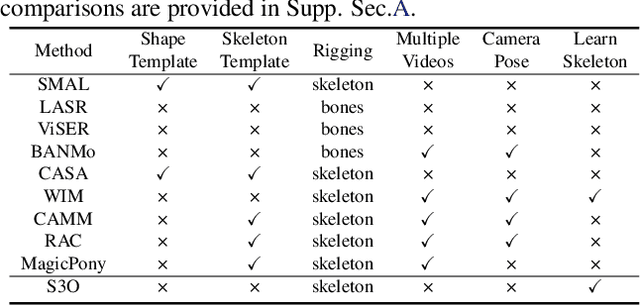



Abstract:Reconstructing dynamic articulated objects from a singular monocular video is challenging, requiring joint estimation of shape, motion, and camera parameters from limited views. Current methods typically demand extensive computational resources and training time, and require additional human annotations such as predefined parametric models, camera poses, and key points, limiting their generalizability. We propose Synergistic Shape and Skeleton Optimization (S3O), a novel two-phase method that forgoes these prerequisites and efficiently learns parametric models including visible shapes and underlying skeletons. Conventional strategies typically learn all parameters simultaneously, leading to interdependencies where a single incorrect prediction can result in significant errors. In contrast, S3O adopts a phased approach: it first focuses on learning coarse parametric models, then progresses to motion learning and detail addition. This method substantially lowers computational complexity and enhances robustness in reconstruction from limited viewpoints, all without requiring additional annotations. To address the current inadequacies in 3D reconstruction from monocular video benchmarks, we collected the PlanetZoo dataset. Our experimental evaluations on standard benchmarks and the PlanetZoo dataset affirm that S3O provides more accurate 3D reconstruction, and plausible skeletons, and reduces the training time by approximately 60% compared to the state-of-the-art, thus advancing the state of the art in dynamic object reconstruction.
 Add to Chrome
Add to Chrome Add to Firefox
Add to Firefox Add to Edge
Add to Edge